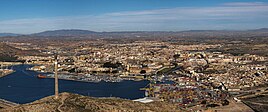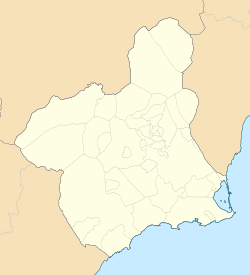
Back Cartagena, Spanje Afrikaans ካርታሔና Amharic Cartachena AN قرطاجنة (إسبانيا) Arabic كارتاخينا ARZ Cartaxena AST کارتاخنا AZB Картахена (Іспанія) Byelorussian Картахэна BE-X-OLD Картахена Bulgarian
Cartagena | |
|---|---|
City Hall The wall of Carlos III Panorama view Pedreño Palace Gran Hotel | |
| Motto(s): Muy noble, muy leal y siempre heroica ciudad de Cartagena | |
 Location of Cartagena | |
| Coordinates: 37°36′7″N 0°59′3″W / 37.60194°N 0.98417°W | |
| Country | Spain |
| Autonomous community | Region of Murcia |
| Province | Province of Murcia |
| Comarca | Campo de Cartagena |
| Judicial district | Cartagena |
| Founded | 227 BC |
| Named for | Carthage |
| Government | |
| • Mayor | Ana Belén Castejón Hernández (Ind.) |
| Area | |
• Total | 558.08 km2 (215.48 sq mi) |
| Elevation | 10 m (30 ft) |
| Highest elevation | 50 m (160 ft) |
| Lowest elevation | 0 m (0 ft) |
| Population (2018)[1] | |
• Total | 213,943 |
| • Density | 380/km2 (990/sq mi) |
| Demonym | Cartageneros |
| Time zone | UTC+1 (CET) |
| • Summer (DST) | UTC+2 (CEST) |
| Postal code | 302xx and 303xx |
| Dialing code | (+34) 968 |
| Website | www |
Cartagena (Spanish: [kaɾtaˈxena] ⓘ) is a Spanish city and a major naval station on the Mediterranean coast, south-eastern Iberia. As of January 2018, it has a population of 218,943 inhabitants.[2] This makes Cartagena Murcia's second-largest municipality and Spain's sixth-largest city that is not a provincial-capital. The wider urban or metropolitan area of Cartagena, known as Campo de Cartagena, has a population of 409,586 inhabitants.
Cartagena has been inhabited for over two millennia, being founded around 227 BC[3] by the Carthaginian military leader Hasdrubal the Fair[4] as Qart Hadasht (Phoenician: 𐤒𐤓𐤕𐤟𐤇𐤃𐤔𐤕 QRT𐤟ḤDŠT; meaning "New Town"), the same name as the original city of Carthage. The city reached its peak under the Roman Empire, when it was known as Carthago Nova (New Carthage) and Carthago Spartaria, capital of the province of Carthaginensis.
Much of the historical significance of Cartagena stemmed from its coveted defensive port, one of the most important in the western Mediterranean. Cartagena has been the capital of the Spanish Navy's Maritime Department of the Mediterranean since the arrival of the Spanish Bourbons in the 18th century.[5] As far back as the 16th century it was one of the most important naval ports in Spain, together with Ferrol in the North. It is still an important naval seaport, the main military haven of Spain, and is home to a large naval shipyard.[6]
The confluence of civilizations, its strategic harbor, and the influence of the local mining industry have led to a unique historic, architectural and artistic heritage. This heritage is reflected in a number of landmarks of Cartagena, including the Roman Theatre, an abundance of Phoenician, Roman, Byzantine and Moorish remains, and a plethora of Art Nouveau buildings from the early 20th century. Cartagena is now established as a major cruise ship destination[7] in the Mediterranean and an emerging cultural focus.
It was the first of a number of cities that have been named Cartagena, most notably Cartagena, Colombia.
- ^ Municipal Register of Spain 2018. National Statistics Institute.
- ^ "Ayuntamiento de Cartagena". Ayto-cartagena.es. Archived from the original on 2 July 2012. Retrieved 26 March 2013.
- ^ "Callejero | Ayuntamiento de Cartagena". Ayto-cartagena.es. Archived from the original on 1 July 2012. Retrieved 26 March 2013.
- ^ "Hasdrubal the Fair - Livius". www.livius.org. Archived from the original on 5 October 2012. Retrieved 26 March 2020.
- ^ "Historia de Cartagena - Región de Murcia Digital" (in Spanish). Archived from the original on 27 July 2020. Retrieved 1 February 2020.
- ^ "El auge económico de Cartagena y la revitalización del sureste español en los siglos XVI y XVII" (in Spanish). 2005. Archived from the original on 21 June 2012. Retrieved 1 February 2020.
- ^ "Autoridad Portuaria de Cartagena". Apc.es. Archived from the original on 8 September 2011. Retrieved 26 March 2013.








